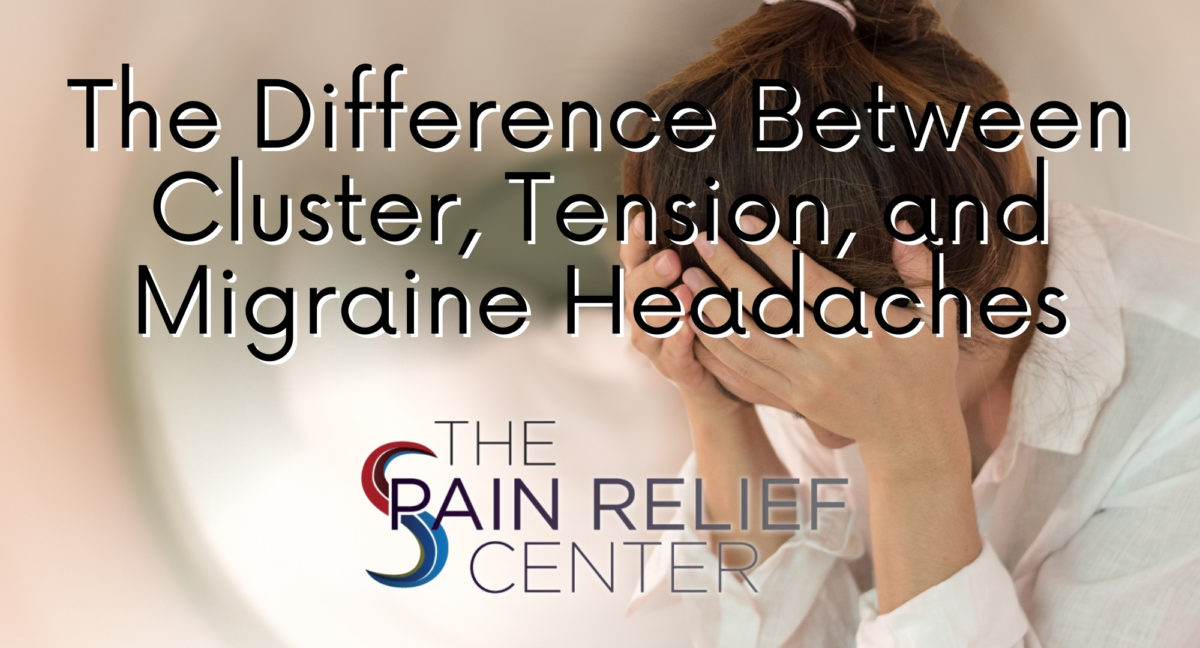To most of us, headaches are just momentary nuisance. We all get them, so we’ll take an OTC pain medication and a nap, and it’s gone by the time we wake up. Not all of us have the pleasure of such an easy recovery, though, and because minor headaches are so common, many aren’t aware of the differences between headache types and the best ways to treat each.
Tension, cluster, and migraine headaches all have different symptoms, triggers, and even pain locations. Additionally, there are several different treatment options depending on the type of headache you experience. Some might even be indicators of something more insidious.
Tension Headaches
Tension headaches are by far the most common type of headache. These headaches are so named because they are derived from muscle tension occurring in the neck and/or scalp. While they are the most common of the variety of headache types in all individuals, they are more common in woman than in men.
Pain Location for Tension Headaches
The pain that accompanies a tension headache does not tend to have a centralized location. Often, the headache pain will begin in the neck (at the back) and move forward, not favoring either side of the head.
Intensity, Severity, and Occurrence for Tension Headaches
Tension headache pain is rated as mild to moderate and is often felt as a dull pressure. Tension headaches don’t cause an interruption in daily activities.
These headaches can last anywhere from 30 minutes to several days, but they are not dangerous to one’s overall health.
Symptoms of a Tension Headache
Tension headaches are rarely, if ever, accompanied by any symptoms other than the pain of the headache itself.
Triggers for Tension Headaches
Environmental and/or internal influences trigger tension headaches, so the list can become pretty long. Some common triggers include the following:
- Lack of sleep/fatigue
- Stress/anxiety
- Hunger
- Overexertion/over-extension
- Problems at home
- Tight deadlines at work
Cluster Headaches
The “cluster” in cluster headache does not refer to location, but the occurrence of this type of headache. In one period of time, a sufferer of cluster headaches will experience an episode multiple times a day. Cluster headaches are not very common, but they do occur more often in men than in women.
Pain Location for Cluster Headaches
The pain of a cluster headache is usually felt on one side of the head, starting behind the eye and radiating outward.
Intensity, Severity, and Occurrence of Cluster Headaches
Cluster headaches are significantly more painful than tension headaches. They can have been described as having a burning or even a piercing quality. These headaches come on very quickly with the pain becoming worse as time goes on. They often interrupt the flow of day-to-day activities, so it is important to seek a healthcare professional for treatment. However, they are not linked to underlying brain conditions (i.e. tumors).
As earlier stated, these headaches occur in clusters during one period of time. The sufferer, during that period of time, will have episodes multiple times a day for the duration. The headaches can last anywhere from half an hour up to three full hours. These episodes of cluster headaches can go through “remission,” but they tend to come back during the same season every year.
Symptoms of a Cluster Headache
Cluster headaches are accompanied by a variety of symptoms including:
- Eye pain/tearing/redness
- Congestion (one-sided)
- Runny nose
Triggers for a Cluster Headache
The direct cause of cluster headaches is unknown, but they occur when a nerve pathway in the brain is activated. This specific pathway is associated with the hypothalamus, which plays a part in our sleep activity. For this reason, cluster headache attacks can wake one up from sleep, as they seem to be linked to circadian rhythms.
Migraine Headaches
Migraines are another severe type of headache with varied triggers that cause unusual neurological activity.
Pain Location of Migraine Headaches
Migraine pain can be one-sided or whole-headed, and pain behind the eyes or in the back of the head is common.
Intensity, Severity, and Occurrence of Migraine Headaches
The pain caused by migraines is very intense and severe. A healthcare professional should be consulted for help in treating the pain, and will often prescribe abortive and preventative medications.
Migraine headaches can last several hours or even days, and the attacks will most likely occur multiple times within a year.
Symptoms of a Migraine Headache
Unfortunately, along with the severe pain of a migraine comes a laundry list of symptoms that can be related. These symptoms include:
- Nausea/vomiting
- Sensitivity to light/noise
- Temporary vision loss
- Pain in the temples
- Seeing spots and/or flashing lights
Auras and Prodrome Phase
Some migraine sufferers will experience auras or go through a prodome phase.
Auras are sensations felt 10-30 minutes before a migraine attack. They include:
- Trouble thinking/focusing
- Vision problems (flashing lights/unusual visuals)
- Tingling/numbness of the face or hands
- Unusual senses (taste/small/touch)
The prodrome phase occurs when one feels symptoms a couple of days before a migraine attack. However, these symptoms can be attributed to other issues, so they don’t necessarily put migraine sufferers on alert. These symptoms can include:
- Depression/irritability
- Neck stiffness
- Abnormal cravings
If you suffer from frequent and painful headaches, The Migraine Institute may be able to help. Call us today to schedule an appointment.


